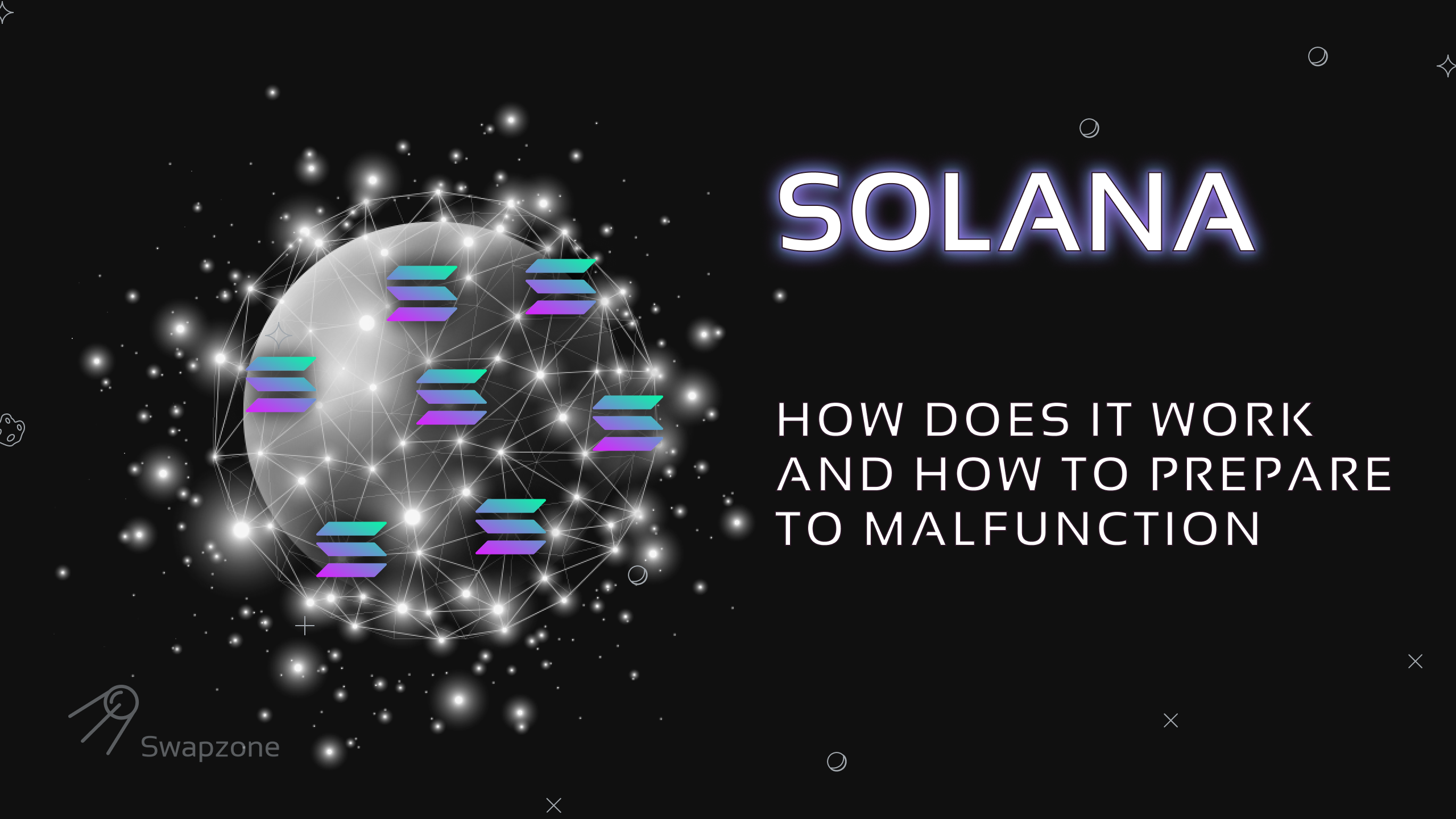Solana has gained popularity due to its impressive features and capabilities. Its scalability, high transaction throughput, and fast confirmation times have attracted developers and users alike, making it an ideal platform for decentralized applications. Additionally, Solana’s low transaction fees compared to other blockchain networks make it cost-effective for users. In this blog post, we’ll dive into the inner workings of Solana and explore its unique features that set it apart from other cryptocurrencies. We’ll also discuss some of the common malfunctions that can occur on the network and offer tips on how to brace yourself for those moments when things might not go as planned.

What is Solana?
Solana is a high-performance blockchain designed for decentralized applications and smart contracts. One of Solana’s key features is its lightning-fast transaction speed. With its unique consensus mechanism called Proof of History (PoH), Solana can process thousands of transactions per second, making it one of the fastest blockchains out there. Solana truly stands out in terms of scalability.
The key to the impressive speed and scalability is a technology called Tower BFT (Byzantine Fault Tolerance). This combination allows Solana to partition transactions across multiple parallel processing units, ensuring efficient utilization of network resources.
So why would people pay attention to Solana? Besides its technical prowess, it has gained recognition for attracting top-tier projects and partnerships within the DeFi space. Its growing ecosystem offers exciting opportunities for developers and investors alike.

How Does Solana Work: Mechanisms and Malfunctions
Solana, a leading blockchain platform, operates on cutting-edge technologies that revolutionize transaction processing and scalability. Its innovative consensus mechanisms and architecture set it apart in the crypto space, making it a preferred choice for developers and users alike.
Proof of History (PoH)
Solana operates on a unique consensus mechanism called Proof of History (PoH). This feature timestamps transactions, creating an ordered sequence that allows validators to agree on the order of events without having to communicate directly. This significantly improves scalability and reduces network latency.
Tower BFT
Another key component of Solana is its Tower BFT (Byzantine Fault Tolerance) consensus algorithm. It leverages a rotating set of verifiers known as “validators” who are responsible for validating transactions and securing the network. Validators stake SOL tokens as collateral, ensuring their accountability.
Multi-Threaded Architecture
Solana employs a multi-threaded architecture that parallelizes transaction processing across multiple cores, maximizing throughput and efficiency. Its innovative approach enables thousands of simultaneous transactions per second with incredibly low fees.
Decentralized Applications (dApps)
Developers can build decentralized applications (dApps) on Solana using smart contracts programmed in Rust or C programming languages. These dApps can leverage the speed and scalability offered by Solana’s infrastructure while benefiting from interoperability with other blockchains through cross-chain bridges.

Malfunctions
However, like any other network, Solana is not immune to malfunctions. While it has gained popularity for its scalability and high transaction throughput, there have been instances where the Solana network has experienced issues.
One of the notable malfunctions was back in December 2020 when a surge in demand overwhelmed the network, resulting in intermittent outages and delays. This incident highlighted the need for further optimization and scaling of the infrastructure.
Another common issue faced by Solana is related to validators going offline or experiencing downtime. Validators play a crucial role in maintaining the integrity of the network, so when they encounter technical difficulties or fail to perform properly, it can disrupt transactions and consensus on the blockchain. On Tuesday, February 9, the blockchain which has witnessed a surge in usage in recent months, experienced an outage, Solana Explorer showed downtime lasting around five hours.
The problem with Solana’s nodes and validators stemmed from a performance degradation in the Mainnet-Beta, leading to a halt in block progression and transaction processing. Core engineers and validators worked to identify and address the issue, requiring an upgrade to the latest software version to prevent loss of delegation status and maintain network security.
Software bugs can also lead to malfunctions on Solana. These bugs may cause unexpected behavior within smart contracts or impact overall system performance. The development team actively works towards identifying and fixing these bugs promptly but occasional hiccups are inevitable.
It’s important for users to stay informed about any known issues with Solana by regularly checking updates from official sources such as forums or social media channels associated with the project. Being aware of potential malfunctions allows you to take the necessary precautions and make informed decisions regarding your crypto activities.
Despite these occasional setbacks, Solana remains a promising blockchain platform with a strong community behind it. So will Solana recover? The development team continues to work tirelessly to address vulnerabilities and improve system stability over time.

How To Prepare Yourself For The Moment When The Network Is Down
Preparing for potential network downtime is crucial when it comes to using Solana or any other blockchain network. While Solana has proven to be highly reliable and scalable, technical glitches and network interruptions can still occur. Here are a few tips on how to prepare yourself in case the Solana network experiences downtime.
1 – Diversify your holdings across different cryptocurrencies and platforms. By spreading your investments, you reduce the risk of being heavily reliant on a single network like Solana. Consider allocating some funds to Ethereum or other established blockchains as a backup plan.
2 – Stay informed about the latest news and updates regarding Solana’s performance. Follow official channels such as their website, social media accounts, and community forums. Being aware of any potential issues beforehand allows you to take the necessary precautions or even make alternative arrangements if required.
3 – Have an offline wallet to protect your assets during network disruptions. Hardware wallets like Ledger or Trezor offer secure storage solutions that are not dependent on an internet connection. Keep these wallets safely stored in multiple locations for added security.
4 – Consider utilizing decentralized exchanges (DEXs) that support cross-chain transactions. These platforms allow users to swap tokens between different networks seamlessly without relying solely on one particular blockchain’s availability.
By implementing these measures ahead of time, you’ll be better positioned to navigate through any possible downtime scenarios while minimizing the risks associated with temporary disruptions in the Solana ecosystem.

How To Swap Solana On Swapzone With The Best Offers
For Solana enthusiasts looking for optimal exchange rates, Swapzone is the answer. It’s a straightforward platform enabling you to compare rates and select the most advantageous exchange options for your Solana tokens. Just input your Solana wallet address and desired amount of SOL, and check the Solana price, and Swapzone will handle the rest, presenting multiple exchange rates side by side and completing Solana crypto swap seamlessly. For example, if you’re interested in popular pairs, such us ETH to SOL, or SOL to ETH, there are several offers available for you on Swapzone.
With additional details like transaction speed and user reviews, Swapzone ensures a seamless swapping experience. Whether you’re a seasoned trader or new to the game, Swapzone simplifies Solana swaps, maximizing your trading potential. Check out Swapzone now for the best offers! Note that the cryptocurrency market is highly volatile. Despite providing technical insights, we want to emphasize that our information does not constitute financial advice.

Conclusion
While no system is perfect, being proactive and prepared can help minimize the impact of any potential malfunctions on your investment or usage of Solana crypto. Stay informed, diversify your portfolio wisely, and leverage tools like Swapzone for seamless swapping experiences!
FAQ
Solana is a high-performance blockchain platform designed for decentralized applications and crypto transactions. It aims to provide scalability, speed, and security while supporting various applications and services.
Solana has proven its resilience in the past by successfully recovering from network disruptions. The development team is actively working on improving the network’s stability to minimize future instances of malfunction.
When purchasing Solana, you have several options available on different cryptocurrency exchanges like Binance, Coinbase Pro, Kraken, Huobi Global, and more. Additionally, consider utilizing Swapzone to compare rates and find the most favorable exchange options for your Solana transactions.
While fluctuations in price may not directly impact the functionality of the network itself, they can influence investor sentiment and overall market dynamics. Increased adoption and positive news surrounding Solana often lead to increased demand and potential price appreciation.
Yes, you can utilize a Solana explorer like “Solscan” or “Solflare” to monitor your transactions on the network. These explorers provide detailed information about transaction history, wallet balances, block confirmations, among other data points.


